Related Research Articles
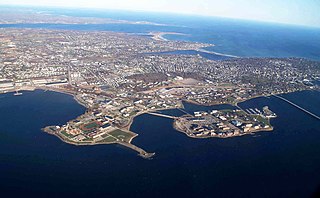
The Naval Station Newport is a United States Navy base located in the city of Newport and the town of Middletown, Rhode Island. Naval Station Newport is home to the Naval War College and the Naval Justice School. It once was the homeport for Cruiser Destroyer Force Atlantic (COMCRUDESLANT), which relocated to Naval Station Norfolk in the early 1970s. In 1989 the base was added to the National Priorities List, after contamination had been discovered years earlier. Newport now maintains inactive ships at its pier facilities, along with the United States Coast Guard. In BRAC 2005, NAVSTA Newport gained over five hundred billets, in addition to receiving, again, the Officer Candidate School (OCS), the Naval Supply Corps School, and several other activities, to include a few Army Reserve units.

The Red Hill Bulk Fuel Storage Facility is a military fuel storage facility in Hawaii. Operated by the United States Navy, Red Hill supports U.S. military operations in the Pacific.
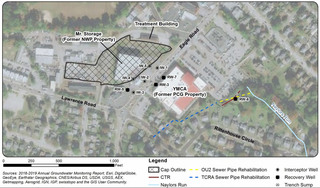
Havertown Superfund is a 13-acre polluted groundwater site in Havertown, Pennsylvania contaminated by the dumping of industrial waste by National Wood Preservers from 1947 to 1991. The state first became aware of the pollution in 1962 and initiated legal action against the owners in 1973 to force them to cleanup the site. The Environmental Protection Agency (EPA) ranked the site the eighth worst cleanup project in the United States. The site was added to the National Priorities List in 1983 and designated as a Superfund cleanup site in the early 1990s. Remediation and monitoring efforts are ongoing and the EPA transferred control of the site to the Pennsylvania Department of Environmental Protection in 2013.
Diamond Alkali Company was an American chemical company incorporated in 1910 in West Virginia by a group of glass industry businessmen from Pittsburgh. The company soon established a large chemical plant at Fairport Harbor, Ohio, which would operate for over sixty years. In 1947, the headquarters of the company was moved from Pittsburgh to Cleveland. Later the company established a plant in Redwood City, California, that produced ion-exchange resins. In 1967, Diamond Alkali and Shamrock Oil and Gas merged to form the Diamond Shamrock Corporation. Diamond Shamrock would go on to merge with Ultramar Corporation, and the combined company, Ultramar Diamond Shamrock Corporation, would in turn be acquired by Valero Energy Corporation in 2001.

Dorney Road Landfill is a 27-acre (11 ha) municipal and industrial landfill in Upper Macungie Township and Longswamp Township, Pennsylvania that was polluted with toxic waste from 1952 to 1978. The site is surrounded by rural residences and farmland. The U.S. Environmental Protection Agency (EPA) added the site to the Superfund National Priorities List in 1984. The site was remediated and removed from the National Priorities List in 2018.

Electrical resistance heating (ERH) is an intensive in situ environmental remediation method that uses the flow of alternating current electricity to heat soil and groundwater and evaporate contaminants. Electric current is passed through a targeted soil volume between subsurface electrode elements. The resistance to electrical flow that exists in the soil causes the formation of heat; resulting in an increase in temperature until the boiling point of water at depth is reached. After reaching this temperature, further energy input causes a phase change, forming steam and removing volatile contaminants. ERH is typically more cost effective when used for treating contaminant source areas.
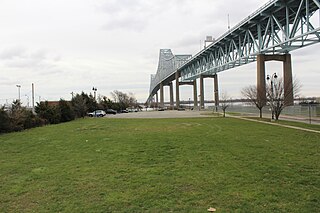
Wade Dump was a rubber recycling facility and illegal industrial waste storage and disposal facility in Chester, Pennsylvania. It was located at 1 Flower Street on the western bank of the Delaware River just north of the Commodore Barry Bridge.
The Escambia Wood Treating Company (ETC) site is located at 3910 Palafox Highway, northeast of the intersection of Fairfield Drive in Pensacola, Florida, and is in a mixed industrial, commercial, and residential area. The site includes the 26-acre property of the former wood preserving facility and over 60 acres of nearby neighborhoods. The facility was in operation from 1942 until 1982, then abandoned by the owner in 1991. During its operation, ETC treated utility poles, foundation pilings, and lumber with creosote and pentachlorophenol. Production byproducts were dumped into on-site, unlined containment pits where they seeped into the surrounding soil and groundwater. Escambia Wood Treating Company
The Oakdale Dump is an Environmental Protection Agency Superfund site located in Oakdale, Minnesota, and comprises three non-contiguous properties that were used for dumping from the late 1940s until the 1950s by the 3M corporation. The properties are named the Abresch, Brockman, and Eberle sites for their respective property owners at the time of disposal activities. The Abresch site is the largest of the three properties at about 55 acres. The Brockman site is located immediately southwest of the Abresch site and encompasses 5 acres. The Eberle site is located roughly 2,500 feet north of the Abresch site and encompasses 2 acres.
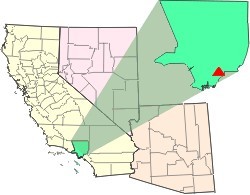
The Waste Disposal Inc. Superfund site is an oil-related contaminated site in the highly industrialized city of Santa Fe Springs in Los Angeles County, California. It is approximately 38 acres (15 ha), with St Paul's high school immediately adjacent to the northeast corner of the site. Approximately 15,000 residents of Santa Fe Springs obtain drinking water from wells within three miles (4.8 km) of the site.
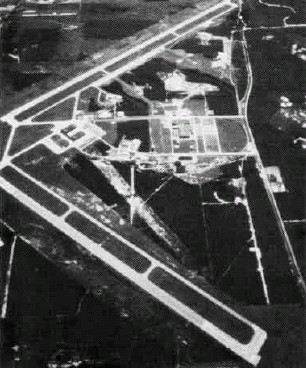
Naval Weapons Industrial Reserve Plant, Calverton (NWIRP) was a government-owned, contractor-operated (GOCO) facility which had the mission of designing, fabricating, and testing prototype aircraft from 1956 until 1996, in Riverhead, New York, United States.
Naval Weapons Industrial Reserve Plant, Dallas (NWIRP) was a government-owned, contractor-operated (GOCO) facility operating from 1941 to 2014 which had the mission of designing, fabricating, and testing prototype weapons and equipment, and is located in Dallas, Texas. The NWIRP first began as an aerospace manufacturing complex constructed for the World War II mobilization program. In 2012, the plant was sold to a private corporation for $357,500. It was located for most of its time next to Naval Air Station Dallas, now known as the Grand Prairie Armed Forces Reserve Complex.
Naval Weapons Industrial Reserve Plant, Bethpage (NWIRP) -- also known as 'Northrop Grumman Site Facility' -- was a United States government-owned, contractor-operated (GOCO) facility established in 1941, with the mission to design, fabricate, and test prototype aircraft for the US Navy and the NASA in the town of Oyster Bay in Bethpage, New York. Two groundwater plumes of toxic chemicals, mostly volatile organic compounds migrating from the property were discovered in 1986 and in 2009, affecting the water district well fields. The site is subject to state Superfund cleanup plans. Special water treatment plants were established in the early 2000s.

Groundwater pollution occurs when pollutants are released to the ground and make their way into groundwater. This type of water pollution can also occur naturally due to the presence of a minor and unwanted constituent, contaminant, or impurity in the groundwater, in which case it is more likely referred to as contamination rather than pollution. Groundwater pollution can occur from on-site sanitation systems, landfill leachate, effluent from wastewater treatment plants, leaking sewers, petrol filling stations, hydraulic fracturing (fracking) or from over application of fertilizers in agriculture. Pollution can also occur from naturally occurring contaminants, such as arsenic or fluoride. Using polluted groundwater causes hazards to public health through poisoning or the spread of disease.
The Newmark Groundwater Contamination Site is a Superfund site located at the base of the San Bernardino Mountains in Southern California. The contamination was discovered in 1980 and resulted in the closing of 20 water supply wells and intensive cleanup efforts in the following years. More than 25 percent of the San Bernardino municipal water supply has been affected by the water contamination since its discovery. The source of the contamination is attributed to a World War II Army landfill and depot, used from 1942 to 1947.
The A.O. Polymer manufacturing site is located in Sparta Township, New Jersey. This facility created special polymers, plastics, and resins. It was also used for reclaiming spent solvents. The facility's poor waste handling led to serious contamination of the ground. It also contaminated the water in the ground with volatile organic compounds. The site has been a threat to the Allentown aquifer, which provides drinking water to over 5,000 people. Initial clean ups started with getting rid of old drums and contaminants from their original disposal area. The company took them and decided to dispose of them elsewhere, thus not fixing the problem. Primary cleanups of the site were ongoing as of 2008. The EPA has been using water pumps to remove contaminants from the water in the ground. A soil extraction system has been put at their disposal to remove harmful contamination within the soil as well. All wells in the affected areas have been closed.
Bog Creek Farm, located in Howell Township, New Jersey, is a designated Environmental Protection Agency (EPA) Superfund site. Lying on 12 acres of land, Bog Creek Farm is home to several hazardous and life-threatening contamination beginning in 1973 and continuing for a year. Over a decade later, actions began to take place to clean and restore the contaminated soil and water. Bog Creek Farm is situated near several other farms that house horses, growing crops and flowers, and livestock. Less than a mile down the road lies Allaire State Park, a park used by golfers, hunters, and fisherman.
Brook Industrial Park (BIP) is an industrial area occupying 4.5 acres of the Borough of Bound Brook, New Jersey, in the United States of America. It is located on the northern bank of the Raritan River. Industrial, chemical and pesticide operations began in 1971 and eventually lead to the contamination of groundwater and exposure of workers to harmful dioxins. Throughout 1980 to 1988 the United States Environmental Protection Agency (EPA) and the New Jersey Department of Environmental Protection (NJDEP) conducted studies to determine if there were any threats being posed on the workers, community or environment by the BIP companies in their disposal of processed and stored chemicals.
The Dorado Ground Water Contamination Site is one of 18 sites listed on the EPA’s National Priorities List in Puerto Rico, a territory of the United States, identified as posing a risk to human health and/or the environment because of a contamination plume in the underlying karst aquifer. Located in north-central Puerto Rico, 20 mi (32 km) to the west of the capital city, San Juan, the Dorado Ground Water Contamination site is located within the Maguayo and Dorado Urbano public water systems, and is the source of drinking water for more than 67,000 people. This site first came under scrutiny by officials in the 1980s and it was officially added to the EPA's Superfund list on September 9, 2016. The EPA is in the process of examining the precise extent and location of this contaminated groundwater plume and, at this time, the contaminants cannot be attributed to any specific source. In the wake of Hurricane Maria, the site has come under increased scrutiny because locals desperate for a source of safe drinking water have been using wells on the superfund site.
References
- 1 2 "Archived copy" (PDF). Archived from the original (PDF) on 2011-07-18. Retrieved 2009-01-15.
{{cite web}}: CS1 maint: archived copy as title (link) - ↑ Bedford NWIRP at projects.propublica.org
- ↑ "NAVAL WEAPONS INDUSTRIAL RESERVE PLANT Site Profile". cumulis.epa.gov. Retrieved 2022-12-07.
- ↑ "Site Descriptions". www.navfac.navy.mil. Retrieved 2022-12-07.
- ↑ "Site Descriptions". www.navfac.navy.mil. Retrieved 2022-12-07.
- ↑ "Site Descriptions". www.navfac.navy.mil. Retrieved 2022-12-07.
- ↑ "Site Descriptions". www.navfac.navy.mil. Retrieved 2022-12-07.
- ↑ "Site Descriptions". www.navfac.navy.mil. Retrieved 2022-12-07.
- ↑ "Site Descriptions". www.navfac.navy.mil. Retrieved 2022-12-07.
- ↑ "NAVAL WEAPONS INDUSTRIAL RESERVE PLANT Site Profile". cumulis.epa.gov. Retrieved 2022-12-08.
- ↑ "NAVAL WEAPONS INDUSTRIAL RESERVE PLANT Site Profile". cumulis.epa.gov. Retrieved 2022-12-08.